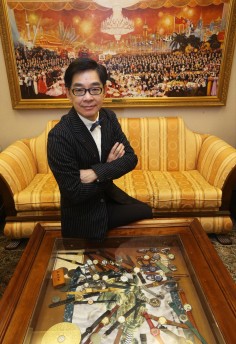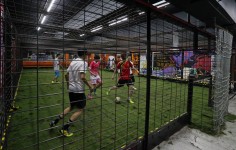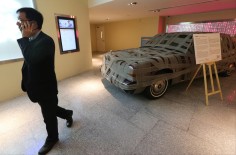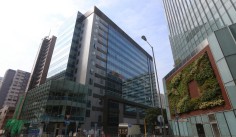
How red tape blocks new uses for surplus Hong Kong factories
Excessive rules and high land premiums hinder efforts to fit the city's unused industrial buildings for new purposes, owners and architects say

Soccer Cages, a mini indoor soccer pitch under a wire-mesh enclosure, exemplifies the transformations inside Hong Kong industrial buildings over the past 20 years. Occupying the first floor of an old factory in Tsuen Wan, the soccer centre has been doing brisk business since it opened six months ago, attracting fans keen to polish their skills in air-conditioned comfort.

"Officials normally just turn a blind eye. Lands Department inspectors have come knocking on our doors, but as long as we don't open them, it's OK."
As the northward exodus of local manufacturing accelerated in the 1990s, makeovers of the spaces they used to occupy took off. Artists' studios, galleries, live music venues, children's playrooms, golf ranges, private kitchens and loft-style homes have popped up in industrial buildings, taking advantage of the bigger spaces and cheaper rents.
Some come within statutory plans that extended usage to activities including training and design. But many more conversions fall outside the remit. This illegal use drew attention again recently when the Lands Department issued warnings to several mini-warehouse operators in industrial buildings for breaching their conditions of use, and ordered the owners to rectify the situation. More recently, unscrupulous owners have turned their units into subdivided flats.
How underutilised industrial buildings can be turned over to alternative uses is a tricky issue in Hong Kong.
Decisions are easier when they are in poor condition: demolish and build again. But repurposing the structures is more challenging for several reasons - among them, fragmented ownership (of the city's estimated 1,400 industrial buildings, only about 400 are solely owned) and high premiums for converting to other usage.

Local conglomerate Campell Group is among the vanguard in major conversions. It has transformed a factory in Kwai Chung into a grade A office building, KC100, which is now ready for tenants.
A second property in Wong Chuk Hang is being turned into a hotel and another in Yau Tong, a hotel and shopping mall. The latter properties were already part of its portfolio, but Campell bought the former garment factory in Kwai Chung for upgrade into offices.
Campell's primary business had previously been in manufacturing, so the group is adapting, too, says its CEO, Eddy Li Sau-hung.
"We are factory owners, not developers. Our profits used to come from manufacturing but as times changed, we changed our business model to operating hotels and renting out office space."
Although his company has tapped into to the revitalisation scheme, Li complains that land use policy fails to keep up with the times and deters factory owners from modifying their buildings for new uses or redeveloping the property.
It takes three years to redevelop an old building. During this period, owners do not receive any rental income but must still pay the land conversion premium. As a result, many factory owners prefer to sell to property developers who have plenty of funds for redevelopment, Li says. But developers will only push up property prices in the area, which in turn drives out the cultural and art groups which rent their space.

"As owners, we want to revitalise the whole neighbourhood," Li says.
"No one wants to sell their properties. But the policy does not encourage factory owners to keep their buildings."
Pang Siu-leung, chief executive of the Hong Kong Economic and Trade Association, echoes Li's views.
Factory spaces sell for about HK$1,000 per sq ft and commercial space for HK$5,000, so owners of industrial buildings must pay the difference of HK$4,000 as the premium for converting land use. But most owners are unwilling to pay this premium because "if you sell to a developer you can get HK$5,000 per sq ft without any hassles".
Moreover, the potential for simply modifying existing structures is limited as the buildings are often on narrow roads with little pedestrian space, so it would be easier to redevelop the site, Pang says.
At the same time, makeovers of industrial buildings are hampered by bureaucracy and technical restrictions that have become obsolete.
We are factory owners, not developers. Our profits used to come from manufacturing but as times changed, we changed our business model to operating hotels and renting out office space
Architect Barrie Ho, who designed the first conversion in Wong Chuk Hang, cites how the Transport Department required 170 parking spaces to be provided at Genesis, the industrial-turned-commercial building.
"Which owner would be willing to devote one third of their building space to car parks?" Ho asks.
"The issue was only resolved after intervention from the now-defunct Development Opportunities Office, which pointed out there was no need for so many parking spaces as the building is near an MTR station."

"The owner [Hip Shing Hong] has the social conscience and great conviction to push through. Other owners would be discouraged by all the requirements."
The government scheme to revitalise factory buildings with low usage is well-intentioned, but officials are often too literal in applying regulations, says Cheung Kwong-wing, an architect whose firm studied the potential of conversion or redevelopment of industrial buildings for several clients.
Building regulations are aimed at safeguarding public health and safety; however, the relevant departments should make exemptions where techniques are available to achieve the intended goal, such as ensuring ventilation or natural light, he argues.
Citing a rule requiring every part of a room for habitation to be within nine metres of an outside-facing window, Cheung says developers should be allowed to adopt compensatory measures such as installing a skylight in the middle of the space. Many projects include several natural-light gathering points to funnel illumination to basements and other indoor spaces.
Similarly, there should be some leeway on requirements for ventilation or parking spaces in factory buildings near MTR stations. "The government should encourage people to use public transport," says Cheung, a director at Dennis Lau and Ng Chun Man Architects and Engineers.
Referring to uses of a factory building that may not fall within the traditional interpretation of industrial activities, a Development Bureau spokesman says the Town Planning Board has occasionally revised permitted use based on social and economic needs.
This included extending the definition of "industrial use" to cover related activities such as training, research, design, development and packaging.
The revitalisation measures aim to facilitate better utilisation of the city's industrial buildings, which are of varying age and condition. It is up to owners to decide whether to convert the structures or redevelop the site based on expected returns, the spokesman says.
Businessmen such as Li, who is also president of the Chinese Manufacturers' Association, describe the "inflexible" programme as a flop. However, the bureau spokesman points out that 108 approved projects under the programme are expected to provide about 1.28 million square metres of converted or new floor space - about seven times the gross floor area of Two IFC.
In any case, the bureau does not expect the scheme to transform a large proportion of existing industrial buildings and does not plan to change the conditions or extend it beyond March next year, he says.
As Professor Eddie Hui Chi-man, an urban renewal expert at Polytechnic University, points out, the government can't lower the premium for converting land use without being accused of favouring factory owners.
"But the government can take reference from other countries. In London, the old Canary Wharf was [designated] an enterprise zone to attract companies to redevelop the area with incentives such as tax rebates. It was later converted into a commercial zone."
Still, Cheung believes the government needs a change in mindset: "They opened the main door to allow people to convert buildings, but the devil is in the details. They need to get departments to coordinate in facilitating the scheme."